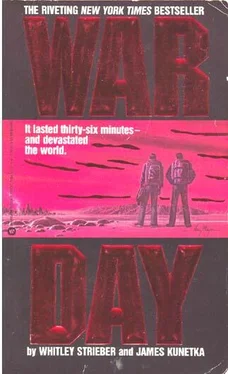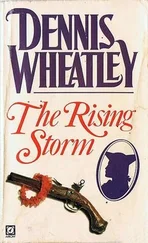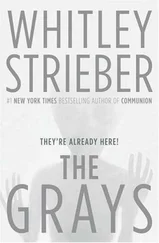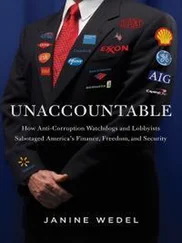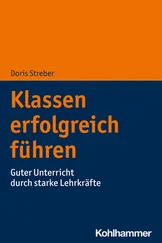Behind her, two blue-uniformed bobbies stand at parade rest in front of the elevators.
“May I help you, please?” she says quickly.
“James Kunetka and Whitley Strieber to see Mr. Shandy.”
Jim’s voice is smooth, his manner calm and affable. He comes here often, looking for news. I cannot help but be uneasy in this foreign-controlled enclave. Like most Americans, my trust in massive central governments is nil. I am uneasy around these British civil servants with their paramilitary pretensions, though I know that their contributions to our welfare have been enormous.
The receptionist types our names into the computer. In a moment the communications console beeps. She picks up the receiver, listens, puts it down. “You can go right up.” She presses a buzzer and one of the bobbies steps forward. By the time he reaches us, she has filled out two green tags. We are expected to put them in our shirt pockets so that, folded out, they can be seen at all times.
We are accompanied to the sixteenth floor by the other bobby.
There, a third policeman shows us to Room 1620, which is marked simply CONTAGIOUS DISEASES. There is a faint smell of sausages and coffee in the hallway.
Another secretary shows us into a cramped outer office, which is dominated by a communications console and computer identical to the ones downstairs. The next moment Jim is introducing me to the inhabitant of the more commodious inner office, a man of medium height with a badly sunburned bald head and a sort of blustering joviality about him. He is in a summer uniform with large wet spots under the arms. He gets right down to business. “I can give you an hour,” he says.
Jim takes off his backpack and pulls out his recorder. “The idea is that you simply talk. We won’t ask many questions. Just tell about your job. Your life here. Whatever you want.”
Shandy regards us. “I’d anticipated questions.”
“Do you feel you need them?” Jim asks.
“Well, I suppose not. It’s just—more convenient, you know.”
His eyes meet mine. His gaze is blue and direct. “Before we start, I want to know a little bit about your plans.”
Jim smiles. “We’re still going to Aztlan, Mr. Shandy.”
Shandy’s lips tighten. “We don’t recommend it.”
The Hispanic Free State that has come into being around El Paso is notorious in this part of Texas. People are terrified of Aztlan. Our visit there will be the first great challenge of our journey.
“Aztlan is extremely dangerous,” Shandy says. “We’d really prefer that you stay in Texas.”
“Who is ‘we’?” I ask.
“The U.K. contingent,” he snaps. Then he picks up the little Sanyo recorder. “You have a disk in this thing?”
“All set. Just start talking.”
Shandy settles back. After a moment, he begins.
INTERVIEW
Charles Shandy, U.K. Relief Official
My work as a public health officer has taken me to many parts of the United States, but I have spent most of my time in Texas, being attached to the United Kingdom Emergency Medical Relief Organization, Southwest Region (HQ) in Dallas, as Director of Contagious Disease Control. I have been here in an official capacity for three years. Prior to the war, my experience in America was limited to a three-week vacation in San Francisco. We exchanged our house with a couple living there, the Mannings. I remember it as being a beautiful city and formed a very favorable impression of the American people from my experiences in California. When the King and the Prime Minister described the situation in America on the telly in the winter of 1988, I was among those who volunteered for the relief effort. One cannot fail to remember the American response during and after World War II, or the close ties between the two countries. I was then assistant managing director of the Albert Doring Company. We specialized in the transport of live vaccines to tropical areas, so I knew a good deal about contagion.
At least, that was what I thought at the time.
During our prewar vacation, my wife and I traveled up and down the West Coast on a train called the Starlight, and really had a great deal of fun. California was beautiful, and the Queen’s having been there the previous spring—that was the summer of ’83—meant that the people were more than usually kindly disposed toward us English.
I have been once to San Francisco since the war, and found it quite a tattered and crowded version of its old self. But certainly recognizable. I went to call on the Mannings, but nobody in the road knew what had become of them. The family occupying their house would not talk to me.
My primary job is to identify outbreaks of treatable contagious disease and allocate appropriate Relief resources to them so that the problem will be minimized. It is not generally understood, but our main function is to supplement existing American services.
The ordinary citizen views the country as being without any internal authority, but this is not the case. There is still a strong federal presence. Certainly in health care. All surviving physicians have, for example, been recorded in a new central registry maintained by the Centers for Disease Control. Hospitals can, as of last year, report their supply needs to the Centers also, and get fairly rapid allocation of medicines and equipment. The loss of records and trained bureaucratic personnel that occurred when Washington was destroyed was certainly damaging to health care, but it has not proved fatal.
I work very closely with the Centers for Disease Control. My experience with the CDC has been very good. The Centers have grown tremendously since the war. There has been great advance in identifying the numerous mutant disease factors that have appeared among the American population. The progress with pseudomonas plague, which has become a significant cause of death in the Southwest since the war, has been spectacular. The death rate from this illness has been reduced to forty-five percent, primarily as a result of the development of nonantibiotic prophylaxis, which was done at CDC. We have helped in educating the population to identify and report plague cases so that isolation and treatment can be effected.
In the past year we have not had the continuous round of problems that were encountered at first. Certainly nothing on the scale of the Cincinnati Flu in ’90. Worldwide deaths from that disease are estimated at approximately two hundred and thirty million, twenty-one million of them in the United States and two million in Europe.
But the U.S. population is better fed and stronger now, so we expect the next pandemic to be less damaging here than was the last.
We anticipate another expression of this hybrid flu, and are relying heavily on CDC results in the development of a treatment regime.
Actually, one of our major projects at present is to teach CDC pneumonia prophylaxis, the construction of steam hats, the various means of assisting the breathing-impaired, control of circulation with hot and cold spots, and such things. CDC has really worked miracles with the very simplest materials and procedures.
The objective of their work is to develop effective medical treatment for serious disease, treatment that can be applied at home by family members and by the victims themselves. On another front, we are underwriting the medical faculties at the new University of Texas Medical School here in Dallas, and providing British doctor-professors so that local medical personnel can concentrate on hospital work.
Despite all this effort, we are not out of the woods. Frankly, however, the drop in U.S. as well as world population is also going to mean a long-term reduction in pandemic disease, if only because the remaining population groups are obviously going to be farther apart and have fewer contacts with one another. Despite this, it must be recalled that, worldwide, health systems remain frail. Supply lines are long and subject to extraordinary stresses. Fuel may be unavailable to move a shipment of drugs from the U.K. to America, for example. On the other hand, the lack of communications—a situation that is really improving fast, by the way—may simply mean that a disease outbreak goes unnoticed by us until it reaches an area where we have a permanent station.
Читать дальше
